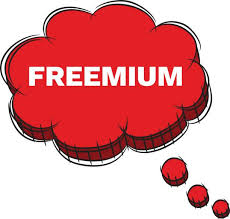Freemium: The popular business model with a funny price

A popular business model among brands offering digital services, Freemium means giving something away for free while gating other, more valuable services behind a pay structure. If you've engaged with brands like Skype, Hootsuite, Evernote, or Spotify, you already have a good understanding of how this works. Learn the ins and outs of the Freemium business model.
Different Freemium Structures
Business owners who choose to offer Freemium services have multiple options when it comes to structuring their business model. Some of the more popular Freemium models include:
Free forever plans. In the case of Evernote, a note-taking app that continues to improve features for teams, there is a basic plan that is free for anyone to use. The basic plan does have limitations, but it is a "base" product that is still valuable - until you need it to be more powerful. With Evernote, the basic plan currently limits syncing to two devices and data transfers to 60MB per month. The paid options increase these limits while adding other features, like pdf markup and offline access to notes. The business goal, in this example, is to get customers to fall in love with the product and ultimately become willing to pay for it.
Ad-driven Freemium products. Take virtually any mobile gaming app on the market and you'll see what makes these Freemium. While the game is free to play and enjoy, attaining new levels or switching back to the home screen may be accompanied by ads. For some app developers, ad revenue is primarily used to support the cost of the app. For others, ad revenue equals profit and an opportunity to cross-market other apps the consumer may enjoy.
Freemium with paid perks. Unlike our Evernote example, bonus features contained within a Freemium product are one-time purchases meant to enhance a user's experience of the product. With this model, we're not asking for a long-term commitment; instead, we're convincing the customer to make an impulse purchase (which adds up to serious revenue). Next time you're on Facebook, try a game like Candy Crush to see this in action. You start with a set, limited number of game "boosters" or helpers and, once they're gone, you're next option is either to spend a long time playing the game to earn them yourself or, for a nominal fee of $.99, purchase these enhanced extras and bust your way through candy-themed puzzles like a pro.
Initial phase Freemium. Sometimes a benefit for startups and entrepreneurs, offering a product for free can be a great way to illicit feedback, test the market, and perfect the product offering. Hulu is a great example of this idea. Hulu started by streaming content online completely free for customers. Granted, it wasn't prime-time quality content, but in the world of Netflix, it was a pretty sweet deal. Hulu used this trial period to learn what customers watched and gradually changed its offering to accommodate the market. Now, Hulu only offers paid plans in its quest to rival Netflix.
Toying with the Idea of Freemium?
As Harvard Business Review points out, there are ways to maximize monetization of Freemium services and not all businesses "get it right." To land lifetime customers, Freemium companies are tasked with effectively anticipating and managing the conversion lifecycle, creating customer evangelists who promote the brand willingly, and innovating their products offerings as the market changes.
What is your favorite Freemium product or service? Tell us in the comments below!
